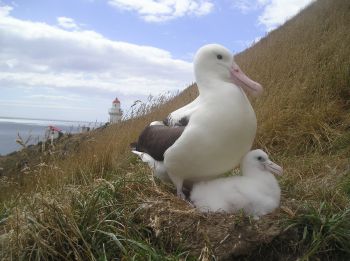The Northern Royal Albatrosses Diomedea sanfordi that breed on Taiaroa Head at the tip of the Otago Peninsula on New Zealand's South Island make up one the very few albatross colonies accessible to the general public without having to join a special (and usually expensive) expedition.
The albatrosses at Taiaroa Head (a Department of Conservation Nature Reserve), unlike at more isolated island colonies, are intensively managed. For example, some chicks are given supplementary feeds by the Royal Albatross Centre; these include fluids, vitamin supplements and fish. Trapping of mammalian predators is ongoing in the colony with 119 rats Rattus sp., eight Stoats Mustela erminea, four domestic cats Felis catus and 12 Common Brushtail Possums Trichosurus vulpecula being caught over the last year.
Two fledglings from the last (2010/11) breeding season have been rescued from the Otago Harbour near the colony. One was returned to the colony from where it successfully flew a few days later, the other was released directly out to sea. Click here to view pictures of the two rescues.

Meanwhile adult birds have been returning for the latest breeding season, with 85 colour-banded birds "clocked in" so far. Red-Orange-Blue (ROB) was the first to return on 13 September, touching down on the spot where he had previously bred. ROB is a 27-year old male. Six years passed between the death of his first partner and his breeding attempts with a second partner. A couple of years later he was bereaved again but found a third partner after two more years. Unfortunately she also died and since 2007 ROB has been on his own. ROB was also the first bird to arrive back for the 2010/11 season.
By late November 30 eggs had been laid in the colony. In the previous season 24 eggs were laid, of which all hatched (click here) with 22 surviving into August.
John Cooper, ACAP Information Officer, 30 November 2011

 English
English  Français
Français  Español
Español